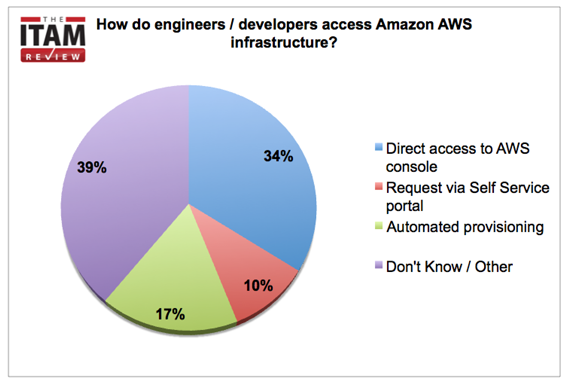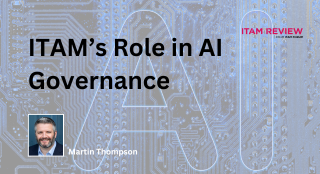Quick guide to managing Amazon AWS costs
In a recent straw poll of ITAM Review readers it was found that only 27% of organisations have some form of portal or automated provisioning process for Amazon AWS.
- 34% of organisations allowed engineers and developers direct access to the AWS console
- 10% orchestrated AWS provisioning via a self service portal
- 17% claimed they had automated provisioning
- and 39% either had other methods or didn’t know how AWS was provisioned
It was just a straw poll and not an exhaustive study, and just because someone is accessing the AWS console directly doesn’t mean their governance is slack, but best practice leans towards some form of portal to automate the provisioning of AWS instances in the same way you might provision perpetual software or SaaS subscriptions via an App Store. AWS basics include switching off unused resources and rightsizing instances and plans.

How to control Amazon AWS costs
Last Thursday Daniel Galecki of Flexera and I hosted a webinar on how to get a handle on Amazon Web Services costs.
The notes below are a quick summary of the main points, links and resources shared during the webinar.
View the recording here. (Registration required)
Agenda
How to Control Amazon AWS Costs – The four principles of controlling and reducing AWS spend whilst maximizing IT productivity and agility
- Introductions
- Amazon in the market
- Amazon Best Practice
- Amazon utilities
- Four principles of AWS cost control
- Business case for IaaS optimisation and key price differentials
- Q&A
Synopsis
The gist of the entire webinar was that ITAM doesn’t want to be a blockage to innovation on the AWS platform, but at the same time we need to wrap governance around usage of AWS to control and manage spend. The best way to do this, as argued in the webinar and also recommended by Amazon best practice was to construct some form of portal or self service mechanism for managing Amazon consumption.
Key talking points and links
Amazon is the Gorilla in IaaS. Microsoft close behind. Gartner predict 37% growth in 2017, volumes treble between 2016 and 2020 from $USD 25.4BN to $USD 72.4BN (Predicted)
Links:
- https://www.theregister.co.uk/2017/06/19/gartner_confirms_what_we_all_know_aws_and_microsoft_are_the_cloud_leaders_by_a_fair_way/
- https://www.gartner.com/newsroom/id/3815165
Four Principles of AWS Cost Optimization
- Understand consumption – Bills, Departments (itemized billing)
- Understand Options (change providers and change plan – low hanging fruit) Plans, Providers
- Processes for Optimization – Capping, Reclaim, Rightsizing, Automation (thermostats, motion sensors, bulbs, automation BMS)
- Ongoing optimization- Benchmarking, improvement plans
Amazon Best Practice
- AWS Well Architected Framework (includes Security, Reliability, Performance, Cost Optimization)
- Paper specifically on cost optimization: https://d0.awsstatic.com/whitepapers/architecture/AWS_Well-Architected_Framework.pdf
Amazon AWS Cost Optimization Utilities
- Understanding Your Usage with Billing Reportshttp://docs.aws.amazon.com/awsaccountbilling/latest/aboutv2/billing-reports.html
- TCO Calculators https://aws.amazon.com/tco-calculator/
- Simply Monthly Calculator https://calculator.s3.amazonaws.com/index.html
- Trusted Advisor – Cost Optimization Checks (Support Contract Required) Checks Amazon EC2 – last 14 days CPU utilization was 10% or less and network I/O was 5MB or less on 4 or more days
- Amazon Cloud Watch (alarms & metrics monitoring) e.g. $100,000 month
What’s coming?
Apps automatically provisioned on AWS (Amazon Ecommerce meets AWS elastic cloud) https://aws.amazon.com/marketplace Time to get our arms around it before horse bolts!
Amazon Alternatives
“The three leading public cloud vendors, AWS, Microsoft Azure and Google Cloud, take very different approaches to pricing and discounts for their services” Datamation https://www.datamation.com/cloud-computing/cloud-price-comparison-aws-vs.-azure-vs.-google.html
Thanks to Daniel and the Flexera team for supporting us on this webinar. If you have any questions around AWS optimisation please leave a comment below or visit our forum.
Cheers, Martin
View the recording here. (Registration required)
Can’t find what you’re looking for?
More from ITAM News & Analysis
-
Broadcom vs Siemens AG - A Brewing Storm
The ongoing legal battle between VMware (under Broadcom ownership) and Siemens is yet another example of why ITAM goes far beyond license compliance and SAM. What might, at first glance, appear to be a licensing dispute, ... -
Shifting Left Together: Embedding ITAM into FinOps Culture
During one of the keynotes at the FinOps X conference in San Diego, JR Storment, Executive Director of the FinOps Foundation, interviewed a senior executive from Salesforce. They discussed the idea of combining the roles of ... -
Addressing the SaaS Data Gap in FinOps FOCUS 2.1
I recently reported on the FinOps Foundation’s inclusion of SaaS and Datacenter in its expanded Cloud+ scope. At that time, I highlighted concerns about getting the myriad SaaS companies to supply FOCUS-compliant billing data. A couple ...
Podcast
ITAM training
Similar Posts
-
The M&S Cyberattack: How IT Asset Management Can Make or Break Your Recovery
Marks & Spencer (M&S), the iconic UK retailer, recently became the latest high-profile victim of a devastating cyberattack. Fellow retailers The Co-Op and Harrods were also attacked. Recent reports suggest the rapid action at the Co-Op ... -
AI in ITAM: Insightful Signals from the Front Line
During our Wisdom Unplugged USA event in New York in March 2025, we engaged ITAM professionals with three targeted polling questions to uncover their current thinking on Artificial Intelligence—what concerns them, where they see opportunity, and ... -
How ISO/IEC 19770-1 Can Help Meet FFIEC Requirements
In the world of ITAM, the regulatory spotlight continues to intensify, especially for financial institutions facing increasing scrutiny from regulatory bodies due to the growing importance of IT in operational resilience, service delivery, and risk management. ... -
An Introduction to Scope 4 Emissions
Executive Summary For ITAM teams, sustainability is a core responsibility and opportunity. Managing hardware, software, and cloud resources now comes with the ability to track, reduce, and report carbon emissions. Understanding emission scopes—from direct operational emissions ...




